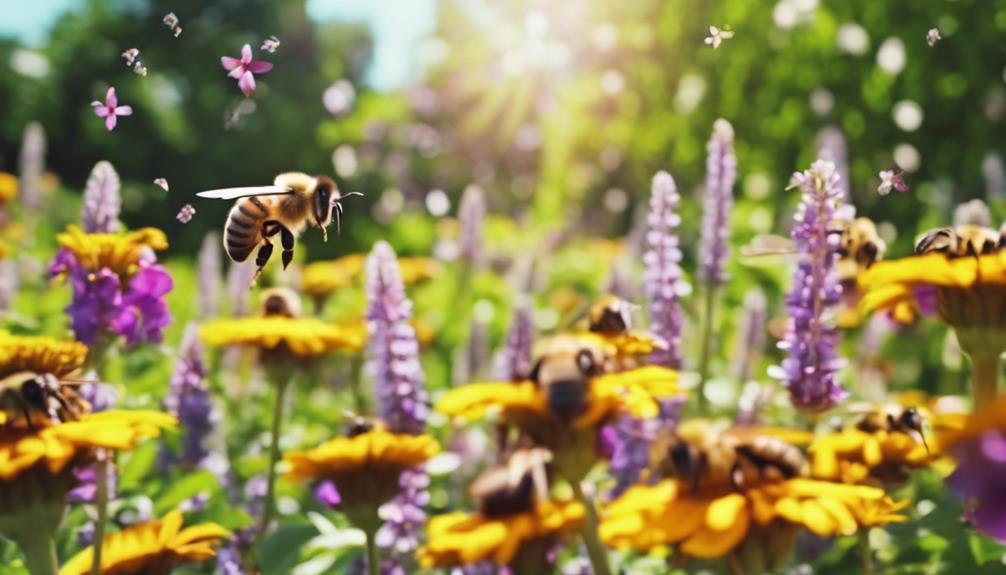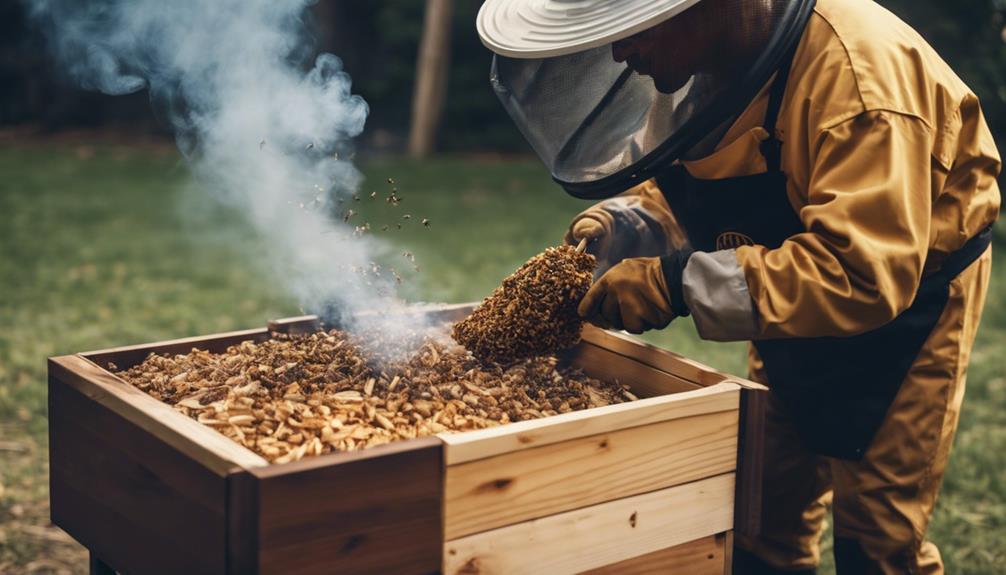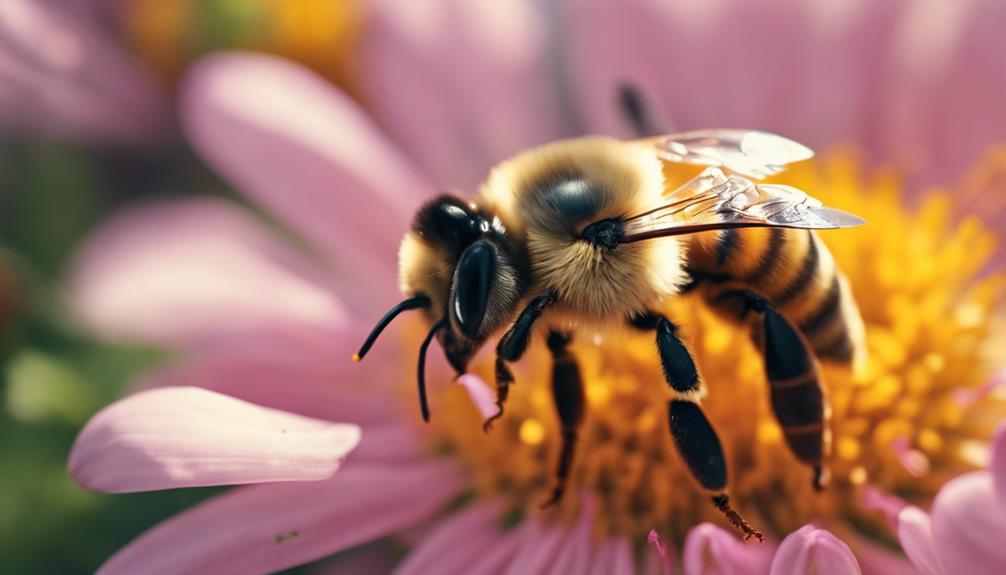In regard to starting beekeeping, April or May are prime months to kick off this sweet endeavor. Springtime brings all the right conditions for our buzzing buddies to thrive; from active bees and blooming flowers to a ready-to-lead queen bee, it’s like the perfect bee party. The longer days and warmer weather provide a welcoming environment for our colony, giving them a head start before nectar flow peaks. So, if April or May sound like the bee’s knees to you, stick around to uncover more about setting up your hive for success.
Main Points
- April or May are ideal months to start beekeeping.
- Fall can also be a good time to begin beekeeping.
- Consider varroa mites threat and treatment plans.
- Research the best time to start beekeeping.
- Understand local regulations and time commitment.
Advantages of Starting in Spring
Starting beekeeping in spring allows us to take advantage of ideal conditions for colony growth and honey production. The bees are buzzing, the flowers are blooming, and the queen bee is ready to lead her hive to success. It’s the perfect time to immerse ourselves in the world of beekeeping.
With the longer days and warmer temperatures, the bees have ample time to establish themselves, gather nectar from the abundant sources, and expand their population swiftly. Spring sets the stage for a thriving hive, ensuring that our bees have the best start possible for the upcoming seasons.
Beehive Establishment in Spring
Establishing a beehive in spring sets the foundation for a successful beekeeping venture, capitalizing on the season’s abundant pollen sources and favorable temperatures. It’s an ideal time to commence your beekeeping journey.
In early spring, bees are gearing up for the season, making it a good time to introduce them to their new home. To help bees survive and thrive, consider feeding them sugar syrup to supplement their food sources.
Starting beekeeping now allows the bees to build a strong colony before the nectar flow peaks. The bees will thank you for setting them up in such a cozy spot when they’re buzzing around collecting pollen in full force.
Optimal Conditions for Spring Beekeeping
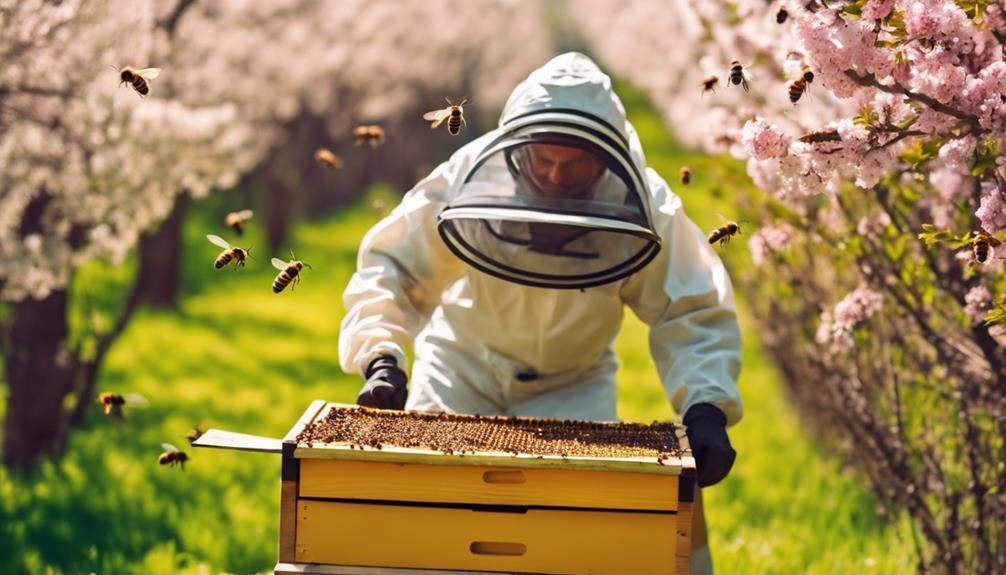
So, you’re considering beginning beekeeping this spring? Well, let’s discuss the prime conditions for your buzzing buddies. From the climate to pollen sources, we’ve got the lowdown to assist your bees thrive.
Ready to delve into some hive inspection tips and make your beekeeping journey as sweet as honey?
Spring Beekeeping Weather
In spring, beekeepers thrive in the ideal weather conditions for beekeeping. Warmer temperatures coax the bees out, encouraging them to forage for nectar and pollen to feed the growing colony. The queen bee, essential to hive development, increases her egg-laying, leading to a bustling population.
Starting beekeeping in spring sets the stage for a successful season ahead, allowing the bees to establish themselves before the peak honey production period. This time of year offers a perfect balance of activity and growth, providing beekeepers with best conditions to kickstart their beekeeping journey.
Hive Inspection Tips
As we examine Hive Inspection Tips for ideal spring beekeeping, beekeepers should prioritize conducting inspections on sunny, tranquil days to evaluate colony health and progress effectively.
- Choose warm, calm days for inspections to avoid agitating the bees.
- Look for signs of brood development to guarantee a thriving colony.
- Check queen activity and honey stores to measure the hive’s strength.
Approaching hive inspections with care and attention to detail allows beekeepers to make informed decisions about hive management. By maintaining a gentle approach and observing key indicators of colony health, such as brood development and queen activity, beekeepers can secure the well-being of their bees and promote a successful beekeeping season.
Pollen Sources for Bees
Investigating various pollen sources during spring beekeeping improves bee nutrition and health, essential for promoting a flourishing hive ecosystem. Bees rely on a diverse diet of pollen from trees, flowers, and crops to obtain the protein needed for their growing brood.
Ever noticed those colorful pollen baskets on their hind legs? Those are their way of collecting and bringing back this essential resource to the hive. Having ample pollen sources in spring is like a power boost for hive strength and population growth.
It’s important to keep an eye on local pollen availability to make certain your bees have access to a nutritious buffet. By staying informed and proactive about pollen sources, you’re setting your hive up for success in the buzzing months ahead.
Importance of Spring Weather
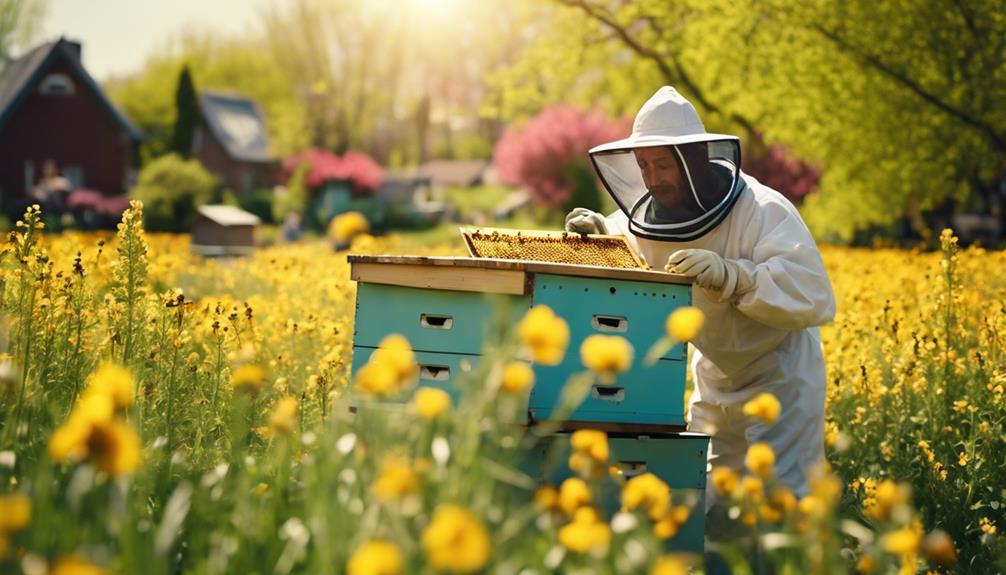
Spring is the time when bees truly come alive, buzzing around in search of nectar and pollen.
The warmer weather helps them thrive, ensuring ideal conditions for their hive-building activities.
As beekeepers, understanding how spring impacts bee behavior and hive development is key to successful beekeeping ventures.
Spring Bee Activity
When do bees become most active in their search for nectar and pollen, signaling the start of their hive-building phase in spring? Spring brings a buzz of activity as bees take to the air, working diligently to gather resources and expand their hive. Here are three key aspects of spring bee activity:
- Foraging Frenzy: Bees avidly scout the landscape for blooming flowers, collecting nectar and pollen to sustain their growing colony.
- Hive Expansion: With warmer weather providing ideal conditions, bees focus on constructing and fortifying their hive, preparing for the coming seasons.
- Population Boom: As bee activity peaks in spring, the bee population within the hive swells, setting the stage for a thriving community throughout the year.
Spring truly sets the stage for a successful beekeeping venture, offering the perfect environment for hive development and bee population growth.
Weather Impact Timing
Optimizing the timing of beekeeping activities in alignment with spring weather patterns significantly influences the success of hive establishment and bee population growth. Spring is the best time to start a beehive, as bees are highly active, aiding in quicker hive building and growth. Cold winter weather limits bee movements, making spring the perfect season to kickstart a new hive.
It’s important to take into account regional variations in spring start times when planning beekeeping endeavors. Aligning hive construction and bee introduction with local spring weather patterns is vital for fruitful beekeeping. So, keep an eye on the changing seasons, and when spring arrives in your area, it’s time to get buzzing with starting your beehive for a successful season ahead!
Hive Preparation Tips
Considering the significance of spring weather in beekeeping success, guaranteeing proper hive preparation is crucial for fostering healthy bee activity and growth. As we gear up for the new hive in spring, here are some tips to give your bees a head start:
- Feeding Bees: Provide supplemental feeding to support the colony until nectar flow increases.
- Worker Bees: Confirm the hive is populated with enough worker bees to support the queen when she starts laying eggs.
- Queen Will Lay: Monitor the queen to make sure she’s healthy and laying eggs consistently to boost colony growth in the first year.
Factors Influencing Beehive Success
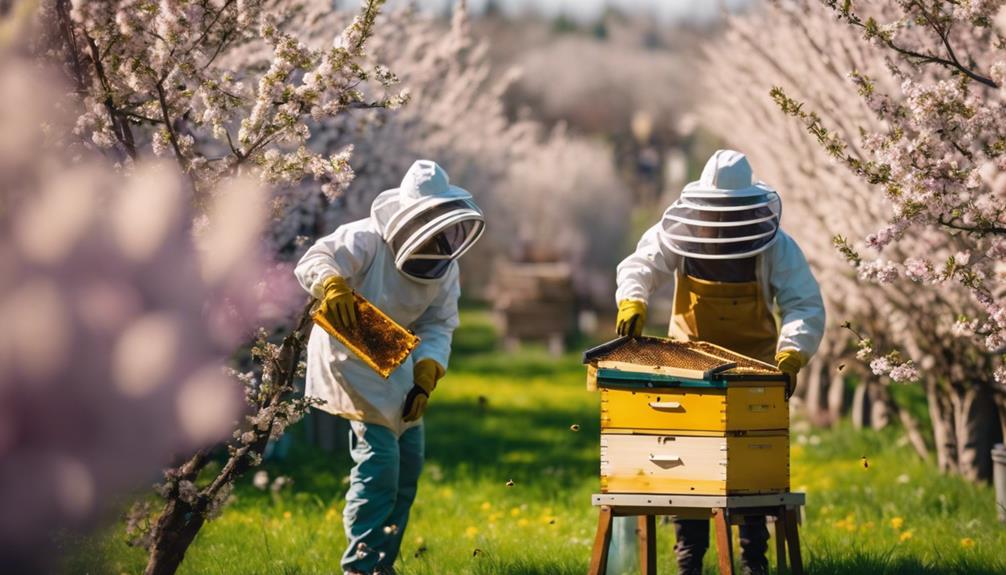
To ensure successful beekeeping, understanding the key factors that impact beehive success is vital. Local beekeepers often recommend starting beekeeping in April or May when the temperature rises, providing ideal conditions for hive setup and maximum production. Fall can also be a great time to begin, as cooler temperatures aid in hive preparation.
Varroa mites, a common threat to beehives, should be considered when starting beekeeping, with proper monitoring and treatment plans in place. Researching the best time of year to start beekeeping in your specific location is essential, as it can vary greatly.
Spring Activities for Beekeeping
Spring brings a flurry of activity for beekeepers as we engage in essential tasks to guarantee the health and productivity of our hives. Here are three key spring activities to kickstart your beekeeping journey:
- Bees Begin Building: As the weather warms up, bees start actively building their hives, expanding their population, and collecting nectar.
- Time to Build: Spring is the perfect time to set up new hives or expand existing ones, ensuring ample space for the growing bee population.
- Local Beekeeping Support: Connect with local beekeeping communities to gather valuable insights, attend workshops, and source bees and equipment for getting started in beekeeping.
Spring is buzzing with opportunities for beekeepers to nurture their hives and set the stage for a thriving colony.

Hello! My name is Noel Calvin. I graduated from UCLA and now work as a writer at Launch Ninjas. I write blog posts that inspire and guide our readers in their entrepreneurial pursuits. I live in Pleasantville, NJ, with a peaceful yet lively atmosphere that inspires me.
Writing stories is more than just a job for me. It allows me to share my observations and satisfy my curiosity about the world. I combine my analytical skills with creative enthusiasm to delve into technology trends and startup stories. But my life isn’t limited to screens and keyboards. I value loyalty, passion, and a touch of old-fashioned charm, which I infuse into every narrative I create.
I love spending time in my garage, jamming with my band when I’m not writing. Playing the guitar and singing bring me immense joy. I also enjoy capturing ordinary and extraordinary moments through my camera lens and exploring new culinary adventures that excite my taste buds. I’m always seeking new experiences.
My family is very important to me. Joyful Sunday brunches filled with laughter and intense board game nights keep me grounded, reminding me of life’s simple pleasures.
In my world, every moment is an opportunity for discovery. Every discovery is a story worth sharing, whether a heartfelt moment at home or the pulse of technological innovations. Join me as I navigate through life, one blog post, one guitar strum, and one heartwarming family dinner at a time.
